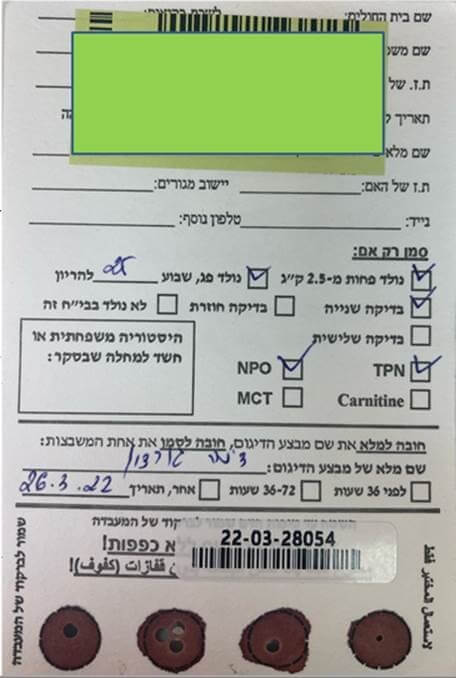
Newborn screening program
The goal of this post is simple – to get you all to know this important project, taking place in many countries around the world.
What is the logic behind Newborn screening program?
Most children are born healthy. But there are a few who look healthy, but actually are at risk for developing a severe illness even in the first few weeks of life.
Without getting too deep into the criteria a disease needs to pass in order to get into the newborn screening program, it is clear to all of us that early recognition of those at risk, will allow preventive treatment as soon as possible.
In some cases, preventive treatment can stop the development of the disease, and in other can decrease the severity of symptoms as well as improving the condition of the patient.
How do you preform the test for newborn screening?
See the picture in the beginning of the post. This is a photo of “Guthrie paper”. This is a blotting paper containing special cotton fibers enabling preservation of dry blood for a long time. The advanced machinery in the lab is designed especially to utilize the small amount of blood soaked in the paper.
In most cases the nurse in the nursery will perform the test before the discharge from the hospital (the test needs to be taken at least 36 hours after birth). She will prick the heel of the baby with a small needle, take 4 drops of blood and blot it to the Guthrie paper. This Guthrie paper will travel to a specially assigned laboratory operated by the national health department in your country, where the test will be analyzed.
How many diseases can be found in newborn screening?
Newborn screening programs differs from country to country. These programs are forever changing and adding additional conditions and diseases that could benefit from early recognition.
Some of these diseases are rare; some are characterized by defective metabolic processes in the body (inborn errors of metabolism).
The most common medical condition diagnosed in newborn screening is congenital hypothyroidism (a condition where the thyroid gland doesn’t function as well as it should be). This condition is a perfect example of a disease that needs to be in the screening program – a disease with a good screening test, with no symptoms in the first weeks of life, and one that without a good screening test would remain hidden until it’s too late. In addition, it is a disease where early intervention will prevent the development of the disease.
What happens in cases where the newborn screening is positive?
In case of a result requiring an immediate intervention, a coordinator from the preforming lab would contact the family and refer them to the hospital (where they can find a specialist who can address the issue). Always remember that a baby with a positive screening test is not necessarily ill, but needs to get tested and go through additional evaluation.
What happens if the newborn screening is negative?
In most settings, if the test didn’t reveal any major problems, no one will contact the parents. However, in most countries the results can be found online, and can be printed out if the parents desire.
Are there other cases in which someone will contact the parents?
Yes. There are several cases in which a test needs to be repeated – usually for technical reasons (insufficient blood, early release from the hospital before the test was taken). In these cases parents will be asked to arrive to the clinic or a hospital and retake the test.
And if the parents have additional questions regarding local newborn screening program?
You can always talk to your pediatrician, or write to the national newborn screening program at your country for more answers.
In conclusion, remember that this important test can discover diseases that can be prevented and can be treated.
For comments and questions, please register
